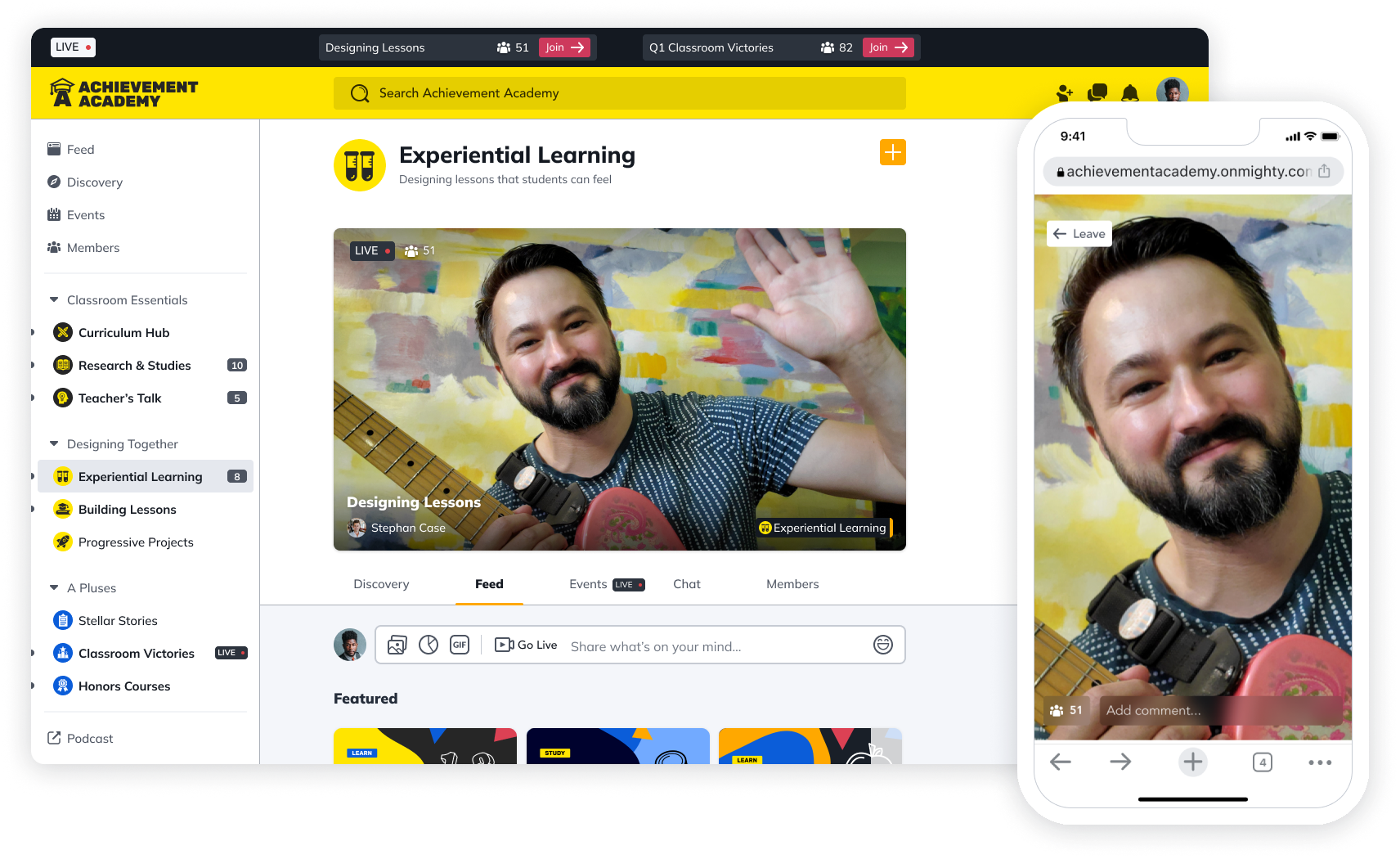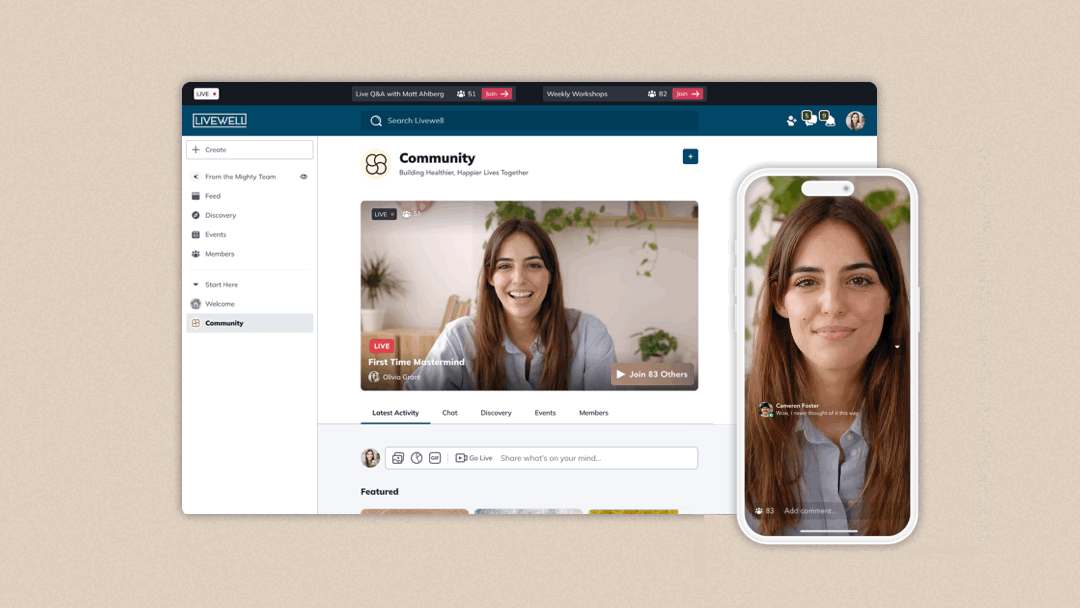Creators & Entrepreneurs
Our 2025 Guide to Recurring Revenue (+10 Business Ideas You'll LOVE)
Finding the right recurring revenue model for your business doesn’t have to be hard.
Author
Mighty Team
Last Updated
February 6, 2025

Generating recurring business income is all the rage, and it's the thing that's built a lot of the most successful brands we engage with every day.
We work with entrepreneurs every day who earn 6-, 7-, and even 8-figures in recurring revenue. If you're ready to build your own recurring income, we'll show you what you need to know. These are some of the lessons we've learned from them.
In this article, we'll:
Define recurring revenue & give examples
Explain the differences between annual recurring revenue (ARR) and monthly recurring revenue (MRR)
Share cool examples of recurring revenue models
Show you why recurring revenue is AMAZING
Give you 10 (proven) recurring revenue business ideas
If you want more support in building your online community business, come join OUR Mighty Community for free and meet other new and established community owners! We’d love to meet you. Join for free!
What is recurring revenue?
Recurring revenue or recurring income is when a customer purchases a service on a consistent basis, whether it’s weekly, monthly, or annually, giving you a reasonable expectation of continuing sales. Recurring revenue creates consistent, predictable income, which is why more and more companies are trying to create it.

Are you old enough to remember when Microsoft came in a box for $79? Now it has recurring revenue products you pay for yearly. That's WAY more lucrative for Microsoft.
Recurring revenue model examples include content subscriptions, paid memberships, and software-as-a-service subscriptions.
Examples of recurring revenue models
Recurring revenue business are all around us: whether they're digital businesses, service-based, or bricks-and-mortar.
Here are some of the MANY examples of recurring revenue you could access:
Subscription-based: Netflix became a $160 billion company thanks to selling $20 subscriptions. Most content companies have gone the same way now: Disney+, Amazon Prime, and Spotify are all built on the same model.

Membership communities: Would you believe that we see 6-, 7-, and even 8- figure brands from membership communities? Amazing brands and creators like Martinus Evans, and Ashley Fox have built thriving businesses for members. The average membership community on Mighty earns $48/mo per member, so it doesn't take an enormous membership to have a thriving business.

SaaS Companies: We mentioned Microsoft above, and a lot of tech and a ton of software-as-a-service (SaaS) companies work on a monthly membership model; think about Dropbox, Evernote, Shopify, and ConvertKit.

Bricks-and-mortar memberships: What do your gym, your price-club grocery store, and your golf course have in common? They all leverage memberships for recurring revenue.
Licensing and royalties: If you've developed a patent for a technology or written a hit song that other artists are covering, you're probably being paid licensing and royalty fees regularly.
Rentals: Commercial leases, rental housing, and even land can be rented out for recurring revenue.
Insurance premiums: Your insurance company makes recurring revenue from your monthly premiums-and they make money when the payouts are lower than the premiums coming in.
Maintenance and servicing contracts: Grass cutting, snow removal, and even filling vending machines, are all local service or maintenance businesses that generate recurring revenue.
Online learning subscriptions: It's not our favorite way to sell an online course, but subscriptions like Skillshare and LinkedIn Learning are examples of recurring revenue earned for those companies from subscription fees. (Whether you as a creator earn recurring revenue is another story.)
Consulting and coaching: Consulting or coaching that's paid out on retainer or on a monthly package can create recurring revenue too!

What is annual recurring revenue?
Annual recurring revenue (ARR) is a way to measure the yearly value of recurring revenue to a business. For example, if you have a community with 1,000 members paying $48/mo each for 12 months: 1,000 x 48 x 12 = $576,000.

What is monthly recurring revenue?
Monthly recurring revenue (MRR) is the recurring revenue your business generates each month. A community of $1,000 members paying $48/mo each for membership has an MRR of $48,000.
In many recurring revenue businesses, the ARR is just a multiplication of the MRR (factoring in churn); this is true for memberships, subscriptions, and SaaS payment models.
But some types of recurring revenue aren't as predictable, and therefore the MRR might fluctuate.
For example:
Owning vending machines at a high school would be recurring revenue, but it would probably fluctuate seasonally (being lowest in summer).
Owning a 6-plex would provide recurring monthly revenue, but if you have vacancies it fluctuates.
Websites that monetize with ads get recurring revenue from it, but the value of ads changes seasonally AND traffic might fluctuate.
Try Our Community Name Generator
Our AI engine is here to help you create a community name that feels like magic. Just share a few words about who your community is for and we’ll get to work.
Examples: coaching clients, meditation novices, vegan chefs, dog lovers, aspiring entrepreneurs, etc.
The names generated by Mighty Co-Host™ are examples only and may be used by other businesses or subject to third-party rights. For more information, check our Terms
What are the benefits of recurring revenue?
Recurring business income is beneficial in some amazing ways that make it great for any business.
Predictable revenue: Predicting revenue and cash flow can be tough in any business. Recurring revenue reduces the stress for a business owner, by helping them know what's coming in.
Know the value of a customer: If you're doing business planning, acquisitions, or even applying for a loan, having a customer lifetime value (CLV) makes this easier. With recurring revenue, you can figure out the value of a customer (calculating the average a customer is "worth" to your business, and accounting for "churn").
Know if your CPA is worth it: Your cost-per-acquisition (CPA), is how much it costs you to get a new customer. For example, if you know that when you spend $500 on ads you get 10 new leads and 5 new customers, your CPA is $100/customer. If the CLV is significantly higher than the CPA, you've got a recipe for growth (depending on how much it costs to service the customers).

Improve your product: Having the baseline of recurring revenue really means you can pour money back into the product, making it even better. Stressing less about customer acquisition lets you build the best possible product which, ironically, does help with getting more customers (through word of mouth and amazing UX).
Better data-based decisions: Recurring revenue businesses have way better data to make decisions with in a way that other companies just can't fathom. Especially with a digital business, you've got the data and analytics to tell you what's working and what isn't.

Easier scaling: Which scales better, a business that needs to keep finding new customers, or a repeat business that keeps its customers month after month? Imagine if any new member you find is added revenue, while you still have revenue from your existing members. THAT's why recurring revenue businesses scale so much faster.
More attractive to investors: Whether you're looking for investors for growth or to be acquired, recurring revenue creates an easy way for investors to be confident about the predictable value of the company.

Recurring revenue wins
When we see amazing member-led businesses built on Mighty, practically all of them have recurring revenue. Here are some of the examples we love from our Hosts:
A health-focused membership community grew to 500 members with $200,000 in ARR.
A premium entrepreneurship mastermind and course-business launched to 60 high-ticket members paying $300/mo, unlocking $216,000 in ARR from week 1.
A brand selling 1-off leadership courses on a website switched to a membership community and quickly grew to 2,000 paying members.
An author and speaker launched a new promotion and added $30,000 in new ARR to their bottom line.
These examples are just the tip of the iceberg, we see results like this every day. And it's one reason why we are BIG on membership and community businesses--there's nothing like it.

Challenges to building recurring revenue
Churn: As great as recurring revenue is, your business can only thrive if it's keeping customers. High turnover--AKA "churn"--will kill your profits.
Competition: Depending on your niche, there may be competition that makes it challenging to grow a recurring revenue business. For example, people pay a lot of channel subscriptions. There may eventually be a point where people are less willing to pay.
Acquisition costs: It costs something to acquire a customer. If these numbers don't make sense, it can kill your business.
Shiny object syndrome: A thriving recurring revenue business is worth it, but it takes time. Some don't stay the course, jumping ship for quicker revenue.
Recurring revenue tools
The tools for building a digital recurring revenue business are better than ever, with a huge crop of useful software to make business automation and streamlining easier than ever.
Here are some of our favorite recurring revenue tools:
Community platforms: Starting here, a great community platform helps you build a member-led growth business quickly, focusing on engagement instead of the administration headaches.
White-label app developers: No need to build an app from scratch, there are a lot of white-label and bespoke app development companies to work with.
Email software automation: Automate email marketing with platforms like ConvertKit.
Project management tools: For building things and working with a team, tools like Monday make it easy to work together.
Customer relationship managers: There are tons of tools for automating customer engagement and gathering useful data.
Fractional service businesses: There are a ton of fractional service businesses to choose from, services like bookkeepers, marketers, HR advisors, community managers, and lawyers. You can get expert advice without hiring someone full-time.
Code and tool marketplaces: If you want to buy a pre-existing solution for your recurring revenue business (e.g. a digital product), there are lots of premade templates and white-label software options available.

Examples of recurring revenue businesses
We talked about a lot of different kinds of recurring revenue businesses above. Now let's talk about some examples and ideas you can use to create your own recurring revenue streams.
Here are 10 businesses with recurring revenue:
Note that we're going to stick with digital business here. If you're looking for different types of recurring revenue, you'll have to do some research.
1. Community

What if we told you there's a recurring revenue business that you can launch in the next 10 minutes, that would grow itself, and that you could manage in a few hours a week?
We're not kidding.
We see again and again that communities are the ULTIMATE recurring revenue stream.
Imagine gathering a group of people around something you care about, Hosting them as they create content and conversations, and watching it grow on autopilot.
It's a powerful model.
It's also why communities are WAY more profitable than any other content-related business you could start. (You can use the creator calculator to get a sense.)

How to build a community
We've got a ton of resources, but start with this guide for how to build an online community.
2. Mastermind group
Mastermind groups are set gatherings of people who meet to share experience and expertise with each other; they exist for entrepreneurs, career-builders, creatives, personal finance, and even parenting.
Masterminds bring together a small, committed group of people with shared goals on a regular basis. During weekly or monthly meetings, group members workshop new ideas, and get perspective and mentoring from their peers, which allows them to build toward success.
In return, they pay recurring monthly dues for access.

Mastermind groups thrive when all the members have experience and expertise to bring to the table.
3. Apps

When you create a mobile app, there are different ways to monetize it, and several of these could be considered recurring revenue.
For example:
Ads: Embedding ads in the content to play periodically can create recurring revenue.
Subscription access: If you charge a recurring monthly fee for your app (for example on an SaaS model), you earn recurring revenue.
Memberships: Premium membership apps are awesome. For example, you could build a fitness app that members pay for every month.
4. Content subscriptions

Another way to make recurring revenue is by creating a content subscription or content membership site that delivers exclusive content to its members, who in turn pay a monthly or annual subscription fee.
This is the model of a lot of online newspapers; for example, the New York Times uses a paywall to monetize its digital content.

You don't need to be a major newspaper to do this. A lot of newsletter software platforms like Substack or ConvertKit let you monetize with your written (or creative) ideas.
You can even connect your premium paid email subscription directly to an online community! For example, Mighty Networks and ConvertKit integrate easily to run your email list and community together.

6. Online course

Here’s another option: Bring in recurring income by creating an online course based on a subject you have expertise or experience in.
We love both live and pre-recorded (synchronous and asynchronous) courses, but pre-recorded are a bit closer to the traditional model of recurring revenue.

Typically, creators charge a one-time fee for an online course--making it not completely recurring. But if the course is pre-recorded and you can sell consistently, it can be awesome passive income.
To boost a course's recurring revenue potential, try connecting a community to it! This way you can keep delivering value.
7. SaaS product
If you've got some technical savvy, a SaaS product can be pretty great recurring revenue. If you can build a helpful tool that people need to use month after month, they can pay for it month after month too.
Here are some ideas for SaaS products that generate recurring revenue:
Marketing or sales tools
Content building and planning tools
Analytics tools
Customer relationship tools
Survey or data tools
Payment and bill-processing tools
Whether you're building a standalone product or a tool bar for a browser, there are a ton of potential options here, and they just keep on expanding with each new technology that emerges (e.g. blockchain, AI).
8. Games & in-game purchases
If you're building a game that requires a subscription, a download purchase, or even in-game purchases or ads, you might have a great basis for a recurring revenue company.
If your product is popular enough, it can generate income month after month. Whether you're building Roblox levels or creating the next Temple Run or Subway Surfers, games are fun, addictive even, and can be good digital businesses too.

9. eCommerce
It's not the perfect recurring revenue business, but an eCommerce business can produce recurring revenue if you've got regular traffic and customers.
Whether you're selling on your own site with Shopify or selling on Etsy, if you've got consistent revenue, you can usually reasonably expect it to continue.

10. Coaching or consulting
Finally, coaching or consulting can be great recurring revenue. Many people work with either coaches or consultants on an on-going basis, making it reasonable to assume that some clients might keep paying for months or even years.
For example, if you were an executive coach or business coach, you'd likely need to work with clients for a period of time to see results. As such, coaching usually works best as a recurring revenue business--when there's time involved to see transformation.

Here are some resources for starting a coaching business if that's your thing:
Also, listen to Cristy "Code Red" Nickel talk about choosing the right platform for a coaching business.
Ready to start?

Generating recurring income comes down to creating a high-value experience for your customer that they can’t get anywhere else.
The easiest way to do that? A Mighty Network. Mighty lets you mix community, content, courses, and commerce. You can use a combination of recurring revenue streams to get them the results they’re looking for. In turn, they’ll return to your subscription, boosting your income.
Try the platform free for 14 days, and watch our AI community builder create your paid membership community in seconds. Seriously. It’s that easy.
Ready to launch your recurring membership business?
Ready to start building your community?
Start a free 14-day trial to explore Mighty—no credit card required.
More like this
Join Mighty Community
Learn the principles of Community Design™ (and see them in action) alongside thousands of creators and entrepreneurs. It's free to join!

Online Courses
Creating a Course
Teaching a Course
Course Platforms
Selling a Course
Communities & Memberships
Community Platforms
Managing a Community
Building a Community
Growing a Community
Monetizing a Community
Content Creation
Creators & Entrepreneurs
Monetization
Content Creation
Starting a Business
Website Builders
Creating & Managing a Website
Events
Event Platforms
Hosting & Marketing Events
Branded Apps
Creating a Mobile App
Coaching Apps
Community Apps
Coaching
Mastermind Groups
Starting a Coaching Business
Coaching Platforms
Filter by Category
Online Courses
Communities & Memberships
Creators & Entrepreneurs
Events
Branded Apps
Coaching



















